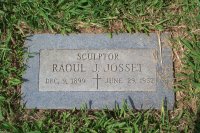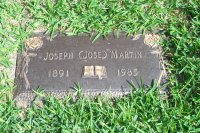|
|
|
See also Public Artwork by Raoul Josset and Jose Martin
Left: Jose Martin with his pioneer woman or founders' statue at Fair Park, Dallas, Texas. Their names were Raoul Josset and Jose (pronounced "Josie") Martin. Lifelong friends who both individually and collaboratively produced some of the most outstanding sculpture ever created in the state of Texas, these two men, like Paris and Dallas, could not have been more opposite. Josset, the debonair ladies' man, was sophisticated and charming, yet lacked either the will or ability to sustain a lasting relationship with a woman. Something of a creative genius, he had the capacity to envision and begin a work of art but left it, in many cases, to his ami Jose to finish it. Martin, in contrast to his friend, was a man whose joie de vie was no doubt the equal of any Frenchman's but whose stability in both his personal and professional life earned him the undying love and respect of the woman with whom he shared his later life and the recognition he deserved as a reliable craftsman of the highest order. Of the two, Raoul Jean Josset was the younger, born in Tours, France on December 9, 1899. His parents had only two children, of which he was the second. The first, also a son, died in childhood. Jose Martin recalled that Raoul "spoke of his father as a jolly man, loving life, horses, drinking, hunting, and making his mother very unhappy." But when Josset was still young, his father disappeared from the family scene, through either divorce or death. Afterward, his mother married Monsieur Josset, a pharmicist whose last name Raoul took for his own and by whom his mother had a third child, Raoul's half-brother Raymond. Although Raoul and Jose did not meet until they were both grown up, when he was "a very young boy" Jose happened to attend the wedding of Raoul's uncle, "a doctor of Burgundy" who "married a young lady in the Chateau of St. Lothian - my village in the Jura country. I remembered the ceremony very well!" The girl, Jose later recalled, was not beautiful, "but she had a dowry of 100,000 francs - very precious at the time to the young country doctor." Raoul, during his adolescence, lived for a time with the his aunt and uncle, whose marriage, he confided in Jose after they met, "was not a very happy one." Raoul also told Jose he often accompanied his uncle when he made his rounds, visiting his patients. "No doubt that if he had not been an artist," Jose once wrote in reference to his friend, "he might have become a doctor." Recalling other familial influences on his friend's life, Jose remembered Raoul's mother as a woman who "was very small in stature," but whose "conversation...culture, (and) ...love and pride she expressed for her sons imposed respect and admiration." He also described Mrs. Josset as "`bourgeoise' to the tips of her fingers." But although "she had an enormous influence on the character of Raoul," Jose wrote, "...he also from a different source of heredity, had a terrific love of life and adventure, a gaiety of character, a great confidence in himself, and also a sort of fatalism." Born in the village of Miery, in the Jura district of France, on April 27, 1891, Joseph Camille Martin came from a family of artists and artisians. His father, age twenty-four when he married sixteen-year old Louise Barriotte, was a furniture-maker from whom his oldest son learned the art of wood-carving. A brother, Jean, also became an artist in wood. At the age of eleven, young Jose passed his primary education exams, which permitted him to leave school. This he did, devoting himself during his adolescence to helping his father "in his profession of wood carver and...all the works of wood that was necessary to do for all his customers of the village, rich or poor." But, he recalled many years later, "Life would have been much better," he recalled many years later, "if the city of St. Lothian, where we lived, had had electricity." His father, he wrote, "worked very hard during the day (and) was forced to work at night" sometimes until 2 or 3 o'clock in the morning, "carving beautiful works of sculpture." Jose helped him by holding "our great lamp of petroleum" by the light of which the elder Martin was able to see what he was doing. At first, Jose found the work so tiring that it made him dislike it and he despaired of ever making a living from wood-carving himself. But, as time went by, he gradually became more confident as he was allowed to try his own hand at the work. At some point during his teenage years, Jose decided he preferred to work with stone rather than wood and within him "the desire to become a sculptor" began to grow. For a long time he kept his feelings to himself but finally, the day came when he told his parents he wanted to leave home, "to realize an impossible dream to go to Paris...to become a sculptor, to learn by study and work...to become a real artiste in this profession." Permitted to pursue his dream, Martin went to Paris where he enrolled at the Ecol de Beaux Arts. But his timing was bad. In 1914, before he could finish, World War One began, interrupting his studies. Responding to his country's call for volunteers, he enlisted in the French Army and served throughout the War, attaining the rank of sergeant. Wounded four times, he was decorated for gallantry, earning both the Medaille du Verdun and the Croix du Guerre, France's highest military honor. In the midst of war, he also found time to get married and in 1916, at the height of the conflict, his wife Jeanne gave birth to a son, André. After the war, the would-be sculptor returned to school in Paris but things were not the same. "I was married," he recalled many years later, "and confronted with the necessity of making a living, and of renewing my studies of sculpture - shattered by four and a half years of military slavery that had been a long and incredible nightmare." In the interim the venerable old professor who had taught Martin's atelier (workshop) had died and in the man's place was a new professor who "was not amiable or understanding to the old students returning from the war." Envious of the students in other workshops who "were having more continuity," he complained that his new professor "was favoring his own young students and many `anciens'...like me, found the situation without hope. For us, our atelier of the Beaux Arts had become a thing of the past." In 1920, Jose Martin met Raoul Josset for the first time when his friend, Pierre Traverse, took him on a visit to Josset's studio. To say that Martin was impressed with Josset and his work would be an understatement. Years later, Martin described the man who became his lifelong friend:
And of Josset's art, he wrote:
During the war, Josset had served as interpreter for the American forces in France. Upon returning to the Ecol de Beaux Arts, he was one of those ex-soldiers of whom Martin was envious, having the same professor who had taught him four years earlier. He was also fortunate in having in his atelier many of the same young men with whom he'd studied previously. The result, Jose Martin observed, was "a community of vision, particularly in the volumes, rhythms and construction of their sculpture, even if they are of different temperment in their inspiration." Between 1920 and 1926 Josset produced a large volume of work, being particularly successful in winning competitions all over France for commissions to design and sculpt war memorials. In addition, he made a number of religious sculptures, including a huge figure of Christ. In 1925, Jose Martin later recalled, Josset "won a Chenanard prize, for a beautiful figure of a soldier. His recompense was a second medal in the salon and a fellowship purse for Italy." Martin also remembered that during this time, Josset "had a charming actress friend who loved him very much and impressed on him the desire to cultivate his voice and diction" which added "to the charm of this little man with his bright intelligence, his love of life and history, his terrific memory. So young looking and attractive with his cherubic face and curled brown hair...his brown eyes alive and audacious, all contributing to make him irresistible!." During this period, Jose Martin was equally busy, both raising a family, which was enlarged in 1920 by the birth of a second son, Jean Pierre, and launching his career in art. After leaving school in 1919, he found employment as a sculptor, working for the Paris designers Louis Sue and André Mare. Of them he wrote:
But Martin was not employed by Sue and Mare exclusively. "When I was not working for them," he recalled, "I was helping another good friend of mine, the sculptor Sartorio." As a result, Martin was able to work on projects as diverse as "the monuments of Alvear of Sao Paulo, Brazil...the frontons of the Opera House in Marsailles and the palace of Mediterranean of Nice - belonging to the American Jay Gould." During these years he also sculpted a war memorial for the town of Danjoutin and a monument to French scientist Louis Pasteur, which was erected in Arbois, Pasteur's birthplace. "In the period 1926-1927," Jose Martin remembered in his later years, "France was in a state of depression...Times were hard for...artists. Monuments to dead soldiers of the war were about finished." As a result, when a Chicago businessman named Lucas visited Europe in 1926, looking for artists to come to the United States to work for the Northwestern Terra Cotta Company, he had no trouble recruiting. Among the sculptors who competed for a position with the company was Jose Martin. "I was accepted," Martin wrote, "but for several reasons...decided later not to take the job." Raoul Josset, "having made a great success in the world of sculpture," found it unnecessary to compete. He was hired on his reputation "and also because he spoke some English - having in his youth lived for a year in England, and having been...during the war an interpreter with the American army." This ability not only got him hired but also led to his being made foreman of the 15 Europeans who made up the group of new Northwestern Terra Cotta Company employees. In 1928, Martin changed his mind about working for the Northwestern Terra Cotta Company but by the time he arrived in Chicago in 1928, there was no longer a job for him. To keep body and soul together, he did some work for Marshall Fields department store. Later, in 1930 and 1931, both Josset and Martin were employed by the Cowan potteries near Cleveland, Ohio. After the effects of the Great Depression put Cowan out of business, the two artists returned to Chicago. There, they were able to find jobs creating sculpture for the 1933 Century of Progress Exposition, the first of the great 1930s expositions. During this period, they also sculpted two colossal statues of Indians for a bridge in Vincennes, Indiana.
When their work for the 1936 Texas Centennial Exposition was finished, both Martin and Josset used Dallas as a base while they worked on various monuments commissioned by towns and cities across Texas. Generally, these projects commemorated historical events or people famous in Texas history. Later, during the Second World War, Martin lived in Seattle, Washington, where he was a pattern-maker for the North American Aviation Company. Josset spent the war years in New York. There, he enjoyed some limited success as an art instructor.
Raoul Josset died suddenly at Baylor Hospital in 1957. By that time, the quality of his work was in decline. Martin, by contrast, did some of his best work later in life. He also lived much longer than his friend, dying at the age of ninety-four in 1985. Considering all the beautiful sculpture these two artists created, it somehow seems inappropriate that both Josset's grave in Calvary Hill Cemetery and Martin's grave at Restland are marked only by simple headstones.
This website copyright © 2002-2004 (except where noted) by Steven Butler. All rights reserved. |
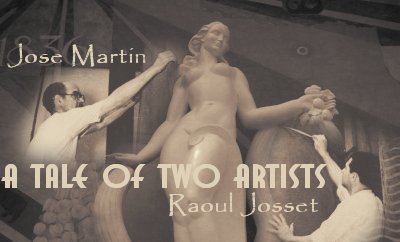
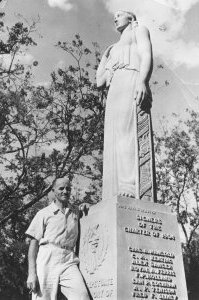 There are certain cities where artists seem to thrive. Paris, France, perhaps more than any other, is one of these. The treasured works of art which adorn its public buildings, hang in its museums, and grace its streets and parks are proof positive that in the capital of France artists are both encouraged and appreciated. Dallas, Texas, in sharp contrast, is a city where the making of money, rather than works of art, is the premier activity and even the appreciation of art pales in comparison to nearby Fort Worth, which has three art museums to Dallas's one. In light of this, how very odd it now seems that two of France's most talented sculptors once lived and worked in Dallas, leaving behind, upon their deaths, a legacy of beauty equal to that of any found in their homeland.
There are certain cities where artists seem to thrive. Paris, France, perhaps more than any other, is one of these. The treasured works of art which adorn its public buildings, hang in its museums, and grace its streets and parks are proof positive that in the capital of France artists are both encouraged and appreciated. Dallas, Texas, in sharp contrast, is a city where the making of money, rather than works of art, is the premier activity and even the appreciation of art pales in comparison to nearby Fort Worth, which has three art museums to Dallas's one. In light of this, how very odd it now seems that two of France's most talented sculptors once lived and worked in Dallas, leaving behind, upon their deaths, a legacy of beauty equal to that of any found in their homeland.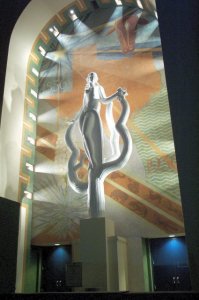 Their work in Chicago led the two men to be hired for the artistic team that created so many of the wonderful Art Deco-style works that can still be seen at Fair Park today. Among the other artists with whom the two Frenchmen worked in 1935-`36 were Lawrence Tenney Stevens, Carlo Campaglia, and Pierre Bourdelle.
Their work in Chicago led the two men to be hired for the artistic team that created so many of the wonderful Art Deco-style works that can still be seen at Fair Park today. Among the other artists with whom the two Frenchmen worked in 1935-`36 were Lawrence Tenney Stevens, Carlo Campaglia, and Pierre Bourdelle. 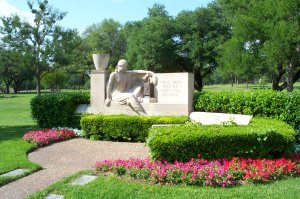 After the war, Martin returned to Dallas. In 1947 he married a local woman, Lucille Meith, whom he had first met in 1936. For several years the couple lived at 616 Exposition, near Fair Park. In his studio, alone or sometimes in tandem with Raoul Josset, Jose Martin created the works of art with which he decorated numerous buildings all over Dallas and elsewhere. These included Baylor Hospital, University Park Methodist Church, Central Christian Church, Highland Park Methodist Church, and the Lakewood Theater. Martin also created decorations for a number of Dallas restaurants. One of his most daunting tasks was to chisel away 15 tons of a 20-ton block of stone, to create a memorial to fallen servicemen for Restland Memorial Park.
After the war, Martin returned to Dallas. In 1947 he married a local woman, Lucille Meith, whom he had first met in 1936. For several years the couple lived at 616 Exposition, near Fair Park. In his studio, alone or sometimes in tandem with Raoul Josset, Jose Martin created the works of art with which he decorated numerous buildings all over Dallas and elsewhere. These included Baylor Hospital, University Park Methodist Church, Central Christian Church, Highland Park Methodist Church, and the Lakewood Theater. Martin also created decorations for a number of Dallas restaurants. One of his most daunting tasks was to chisel away 15 tons of a 20-ton block of stone, to create a memorial to fallen servicemen for Restland Memorial Park.